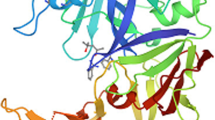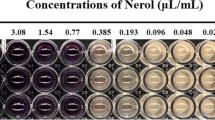Abstract
The aim of the present study was to isolate the active compound against Candida albicans from the methanolic extract of aerial part of Mollugo pentaphylla Linn. and to peruse in vivo animal model of oral candidiasis. The study was designed to quantify the oral candida infection with different statistical approach and histopathological observation of infected tongue on treatment with 100 µg/mL of the isolated compound. The significance of age, body weight and tongue weight was also correlated with disease treatment on either sex of animal. The isolated active compound was characterized as stigmasterol (EX-1) based on FTIR, DSC, 1H NMR, 13C NMR and mass spectral analysis. An in silico docking approach predicted strong negative binding energy efficacy of stigmasterol with C. albicans PKh Kinase protein unveiled an in-visual perception for anticandidal efficacy.













Similar content being viewed by others
References
Aguiree-Urízar JM (2002) Oral candidiasis. Rev Iberoam Micol 19:17–21
Bensadoun RJ, Patton LL, Lalla RV, Epstein JB (2011) Oropharyngeal candidiasis in head and neck cancer patients treated with radiation: update 2011. Support Care Cancer 19:737–744
Bernhardt J, Herman D, Sheridan M, Calderone R (2001) Adherence and invasion studies of Candida albicans strains, using in vitro models of esophageal candidiasis. J Infect Dis 184:1170–1175
Cayne JM, Ragasa CY (2004) Structure elucidation of stigmasterol and B-sitosterol from Sesbania grandiflora (Linn.) Pers. and B-carotene from Heliotropiumindicum Linn. by NMR spectroscopy. KIMIKA 20:5–12
Doddanna SJ, Patel S, Sundarrao MA, Veerabhadrappa RS (2013) Antimicrobial activity of plant extracts on Candida albicans: an in vitro study. Ind J Dent Res 24:401–405
Dupont BF, Dromer F, Improvisi L (1996) The problem of resistance to azoles in Candida. J Mycol Medsuppl II:12–19
Farah CS, Lynch N, McCullough MJ (2010) Oral fungal infections: an update for the general practitioner. Aust Dent J 55:48–54
Ferrer J (2000) Vaginal candidiasis: epidemiological and etiological factors. Int J Gynaecol Obstet 71:21–27
Flaitz CM, Hicks MJ (1999) Oral candidiasis in children with immune suppression: clinical appearance and therapeutic considerations. ASDC J Dent Child 66:161–166
Hata K, Kimura J, Miki H, Toyosawa T, Moriyama M, Katsu K (1996) Efficacy of ER-30346, a novel oral triazole antifungal agent in experimental models of Aspergillosis, Candidiasis and Cryptococcosis. Antmicrob Agents Chemother 40:2243–2247
Haynes K (2001) Virulence in Candida species. Trends Microbiol 9:591–596
Hosahally RV, Seru G, Sutar PS, Joshi VG, Sutar KP, Karigar AA (2012) Phytochemical and pharmacological evaluation of Tragiacannabina for anti-inflammatory activity. Int Curr Pharm J 1:213–216
Järvensivu A, Hietanen J, Rautemaa R, Sorsa T, Richardson M (2004) Candida yeasts in chronic periodontitis tissues and subgingival microbial biofilms in vivo. Oral Dis 10:106–112
Jayanta KP, Eun SK, Kyounghee O, Hyeon-Jeong K, Yangseon K, Kwang-Hyun B (2014) Antibacterial effect of crude extract and metabolites of Phytolacca americana on pathogens responsible for periodontal inflammatory diseases and dental caries. BMC Complement Altern Med 14:2–6
Jehan B, Shehla K, Mohammad S (2014) In Vitro antimicrobial activity of Allium cepa (dry bulbs) against positive and Gram negative bacteria and fungi. Pak J Pharm Sci 27:139–145
Junqueia JC, JdaS Martins, Faria RL, Colombo CED, Aoc Jorge (2009) Photodynamic therapy for the treatment of buccal candidiasis in rats. Lasers Med Sci 24:877–884
Kauffman CA, Carver PL (1997) Antifunal agents in the 1990s current status and future developments. Drugs 53:539–549
Klis FM, Sosinska GJ, de Groot PW, Brul S (2009) Covalently linked cell wall proteins of Candida albicans and their role in fitness and virulence. FEMS Yeast Res 9:1013–1028
Margaix-Muñoz M, Bagán JV, Poveda R, Jimėncz Y, Sarrión G (2009) Sjögren syndrome of oral cavity. Review and update. Med Oral Patol Oral Cir Buccal 14:E325–E330
Martinez A, Regadera J, Jimenez E, Santos I, Gargallo-Viola D (2001) Antifungal efficacy of GM237354, a sordarin derivatives, in experimental oral candidiasis in immunosuppressed rats. Antimicrob Agent Chemother 45:1008–1013
Morris GM, Goodsell DS, Halliday RS, Huey R, Hart WE, Belew RK, Olson AJ (1998) Automated docking using a Lamarckian genetic algorithm and empirical binding free energy function. J Comput Chem 19:1639–1662
Morris GM, Huey R, Lindstrom W, Sanner MF, Belew RK, Goodsell DS, Olson AJ (2009) Autodock4 and Auto Dock Tools4: automated docking with selective receptor flexibility. J Comput Chem 30:2785–2791
Nath MC, Chakravorty MK, Chowdhury SR (1946) Liebermann–Burchard reaction for steroids. Nature 157:103–104
Niyogi P, Pattnaik S, Maharana L (2016) Quantitative identification of major and minor constituents of aerial part of Mollugo pentaphylla Linn. Using GC-MS. Asian J Chem 28:2335–2338
Pastor-Flores D, Schulze JO, Bahí A, Süß E, Casamayor A, Biondi RM (2016) Lipid regulators of Pkh2 in Candida albicans, the protein kinase ortholog of mammalian PDK1. Biochimicaet Biophysica Acta 1861:249–259
Pattnaik S, Niyogi P, Maharana L, Panigrahi L (2014) Formulation, evaluation and solid-state thermographic characterization of CFC free Beclometasone Dipropionate pressurized metered dose inhalation. Int J Pharm Pharm Sci 6:398–403
Ramaiya SD, Bujang JS, Zakaria MH (2014) Assessment of total phenolic, antioxidant, and antibacterial activities of Passiflora Species. Sci World J 2014:1–10
Ray TL, Payne CD (1998) Scanning electron microscopy of epidermal adherence and cavitation in murine Candidiasis: a role for Candida acid proteinase. Infect Immun 56:1942–1949
Raz-Pasteur A, Ullmann Y, Berdicevsky I (2011) The pathogenesis of Candida infections in a human skin model: scanning electron microscope observations. ISRN Dermatol 2011:1–7
Reshma MV, Balachandran C, Sunderasan A, Arumughan C, Sukumaran D, Thomas S, Saritha SS (2010) Extraction, separation and characterisation of sesame oil lignin for nutraceutical applications. Food Chem 120:1041–1046
Samaranayake YH, Samaranayake LP (2001) Experimental oral candidiasis in animal models. Clin Microbiol Rev 14:398–429
Slote J (2002) Selection of antimicrobial agents in periodontal therapy. J Periodontal Res 37:389–398
Solis NV, Scott G (2012) Filler mouse model of oropharyngeal candiadosis. Nat Protocol 7:637–642
Takakura N, Sato Y, Ishibashi H, Oshima H, Ushida K, Yamaguchi H, Abe S (2003) A novel murine model of oral candidiasis with local symptoms characteristic of oral thrush. Microbiol Immunol 47:321–326
Totti MAG, dos Santos EB, de Almeida OP, Kanga-Ito CY, Jorge AOC (2004) Oral candidosis by Candida albicans in normal and Xerostomic mice. Braz Oral Res 18:202–207
Trott O, Olson AJ (2010) Auto Dock Vina: improving the speed and accuracy of docking with a new scoring function, efficient optimization, and multithreading. J Comput Chem 31:455–461
Valarmathi R, Rajendran A, Senthamarai R, ShakilaBanu S, Punitha P, Priyadharshini S (2013) Effect of methanolic extract of Mollugo pentaphylla on blood glucose levels in streptozotocin induced diabetic rats. Int J Pharm Phytopharmacol Res 3:42–43
Vanden Berghe DA, Vlietinck AJ (1991) Screening methods for antibacterial and antiviral agents from higher plants. In: Dey PM, Harbone JD (eds) Methods in plant biochemistry. Academic Press, London, pp 47–69
Villar C, Dongari-Bagtzoglou A (2008) Immune defense mechanisms and immune enhancement strategies in oropharyngeal candidiasis. Expert Rev Mol Med 10:e29
Villar CC, Kashleva H, Mitchell AP, Dongari-Bagtzoglou A (2005) Invasive phenotype of Candida albicans affects the host proinflammatory response to infection. Infect Immun 73:4588–4595
Wyk CV, Steenkamp V (2011) Host factors affecting oral candidiasis. South Afr J Epidemiol Infect 26:18–21
Acknowledgements
The authors are thankful to the DST, Government of India, for providing the fund under the INSPIRE Fellowship toward Mr. Partha Niyogi (IF 130395); Siksha ‘O’ Anusandhan Deemed to be University; and IMS & SUM Hospital, Odisha, India, to carry out the research work. The authors are also thankful to taxonomist, Dr. A. K. Pradhan, Professor, Department of Botany, PPD Mahavidyalaya, Tigiria, Cuttack, Orissa, India, to authenticate the plant.
Author information
Authors and Affiliations
Corresponding author
Ethics declarations
Conflict of interest
The authors declare that they have no conflict of interests.
Electronic supplementary material
Below is the link to the electronic supplementary material.
Rights and permissions
About this article
Cite this article
Niyogi, P., Pattnaik, S., Maharana, L. et al. An Epidemiological Correlation of Oral Candidiasis Mice Model Study of an Isolate from Mollugo pentaphylla Linn. and In silico Docking Approach. Iran J Sci Technol Trans Sci 43, 785–799 (2019). https://doi.org/10.1007/s40995-018-0619-4
Received:
Accepted:
Published:
Issue Date:
DOI: https://doi.org/10.1007/s40995-018-0619-4




